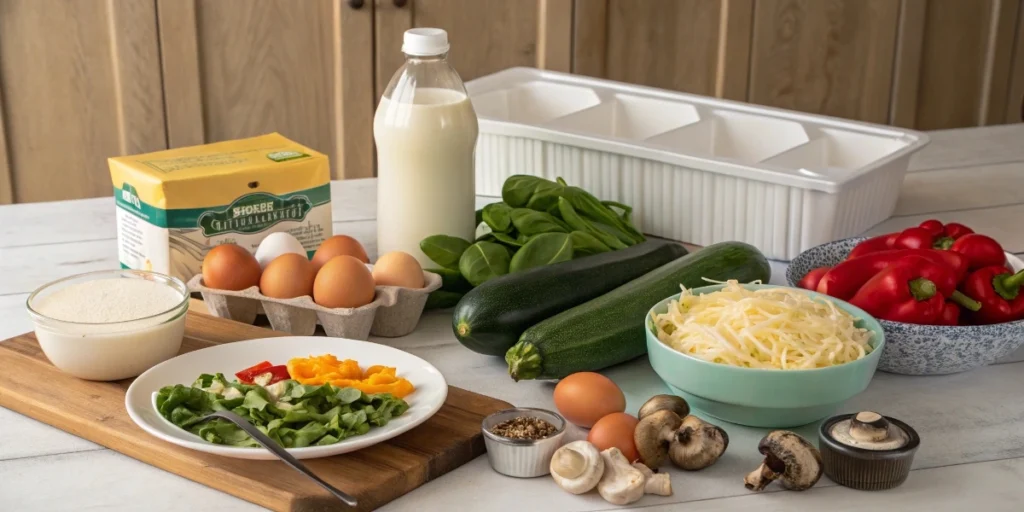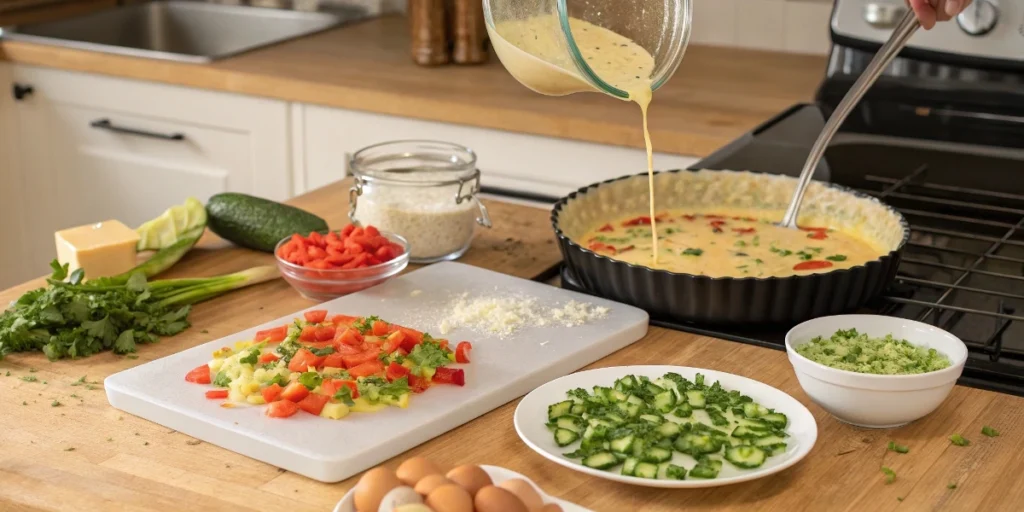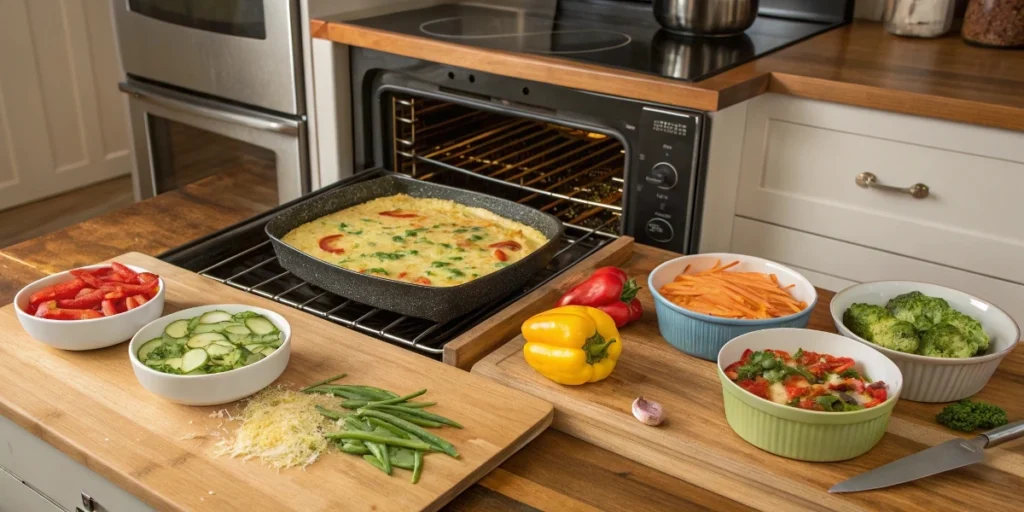Have you ever wondered if it’s possible to make a meal that’s both healthy and easy enough for even the busiest weeknights? Enter the Baked Vegetable Frittata , your new go-to dish that’s as nutritious as it is satisfying. Whether you’re feeding yourself or a crowd, this recipe promises flavor-packed goodness without hours in the kitchen. Ready to discover how this simple egg-based wonder can transform your meals? Let’s dive in.
Table of Contents
Why This Baked Vegetable Frittata Stands Out
What makes the Baked Vegetable Frittata so special? For starters, it’s a one-pan wonder! That means minimal cleanup—always a win. Plus, it’s versatile, quick to prepare, and packed with nutrients from colorful veggies. You can whip up this dish in under an hour, making it perfect for breakfast, brunch, lunch, or dinner.
Time Requirements:
- Prep time: 15 minutes
- Cook time: 30-35 minutes
- Total time: ~45 minutes
Difficulty Level:
Beginner-friendly! If you can crack eggs and chop vegetables, you’ve got this covered.
The baked vegetable frittata is not just another egg dish; it’s a canvas for creativity. Whether you’re using leftover vegetables from last night’s dinner or experimenting with seasonal produce, this recipe adapts beautifully to whatever ingredients you have on hand. Its simplicity ensures that even novice cooks can achieve restaurant-quality results without breaking a sweat.
Essential Ingredients for Your Baked Vegetable Frittata

The beauty of this dish lies in its simplicity. Here are the star players:
- Eggs : The backbone of any frittata, eggs provide protein and act as a binder for all those delicious veggies. They also contribute to the fluffy texture that makes this dish so comforting.
- Milk or Cream : Adds creaminess and helps fluff up the texture. Whole milk or heavy cream works best, but lighter alternatives like almond milk or oat milk can be used for a dairy-free option.
- Cheese (optional) : Shredded cheddar, Parmesan, or feta adds richness and depth. Cheese lovers will appreciate the gooey pockets of melted goodness scattered throughout the frittata. However, if you’re avoiding dairy, simply omit it or use nutritional yeast for a cheesy flavor.
- Vegetables : Bell peppers, zucchini, spinach, mushrooms, onions—the possibilities are endless! These veggies not only add color and texture but also pack the dish with essential vitamins and minerals.
- Seasonings : Salt, pepper, garlic powder, paprika, or fresh herbs like parsley elevate the flavors. Don’t underestimate the power of seasoning—it’s what transforms a basic dish into something extraordinary.
Alternatives & Differences:
- Dairy-Free Option : Swap milk/cream for almond milk or coconut cream. Nutritional yeast can replace cheese for a similar umami flavor.
- Vegan Twist : Use tofu scramble instead of eggs. Silken tofu blended with turmeric and black salt mimics the taste and texture of eggs remarkably well.
- Low-Carb Version : Skip starchy veggies like potatoes; stick to leafy greens and low-carb options such as cauliflower or broccoli.
Each ingredient plays a role in creating layers of flavor and nutrition. Feel free to mix and match based on what’s in your fridge! The flexibility of this recipe allows you to tailor it to your dietary preferences or restrictions without compromising taste.
Step-by-Step Instructions for Making a Perfect Baked Vegetable Frittata

Follow these steps to create a mouthwatering masterpiece:
Step 1: Preheat and Prep
Start by preheating your oven to 375°F (190°C). While the oven heats up, grease a 9-inch pie dish or cast-iron skillet with olive oil or non-stick spray. Using a cast-iron skillet gives the frittata a rustic charm and ensures even cooking, but a regular baking dish works just fine too.
Step 2: Sauté Your Veggies
Heat some olive oil in a pan over medium heat. Add chopped onions and sauté until translucent. Onions form the flavor base of the dish, so take your time caramelizing them slightly for added sweetness. Once the onions are soft, toss in other veggies like bell peppers, zucchini, or mushrooms. Cook until they’re tender but still vibrant. Avoid overcooking, as the vegetables will continue to soften in the oven.
Pro Tip: Avoid watery veggies like tomatoes during cooking—they release moisture that can make your frittata soggy. Instead, sprinkle them on top before baking. This trick keeps the structure intact while adding bursts of juicy flavor.
Step 3: Whisk the Egg Mixture
In a large bowl, whisk together 6-8 eggs (depending on how thick you want it), ¼ cup of milk or cream, and seasonings. Make sure to whisk thoroughly to incorporate air, which helps the frittata rise and become light and airy. Stir in half of your shredded cheese for extra gooeyness.
Step 4: Combine Everything
Spread your sautéed veggies evenly across the bottom of your prepared dish. Pour the egg mixture over the veggies, ensuring everything is well-distributed. Use a spatula to gently spread the mixture around, filling any gaps between the vegetables. Top with remaining cheese and any additional garnishes like sliced cherry tomatoes or fresh herbs.
Step 5: Bake to Perfection
Place the dish in the preheated oven and bake for 30-35 minutes. Check doneness by inserting a knife into the center—it should come out clean. The edges will puff up slightly, and the top will turn golden brown. Remove from the oven and let it rest for 5-10 minutes before slicing. Allowing it to rest ensures the frittata sets properly and makes slicing easier.

Assembly Tips for a Beautiful Presentation
Presentation matters, even when it comes to comfort food! Here’s how to assemble your Baked Vegetable Frittata for maximum appeal:
- Layer Wisely : Start with sturdy veggies at the base (like onions) and lighter ones on top (like spinach). This creates a balanced distribution of flavors and textures.
- Color Contrast : Mix bright colors like red bell peppers, green spinach, and yellow squash for visual pop. A rainbow of hues not only looks appetizing but also signals a nutrient-rich meal.
- Garnish Generously : A sprinkle of fresh basil or parsley adds elegance and freshness. Consider drizzling a bit of balsamic glaze or hot sauce for an extra kick.
Serve slices warm with a side salad or crusty bread for a complete meal. For brunch gatherings, pair the frittata with mimosas or freshly squeezed orange juice for a touch of luxury.
Storage and Reheat Tips for Freshness
Leftovers? Lucky you! The Baked Vegetable Frittata stores beautifully:
- Refrigeration : Store in an airtight container for up to 4 days. Keep it away from strong-smelling foods to prevent odors from seeping in.
- Freezing : Wrap individual slices in plastic wrap and freeze for up to 2 months. Label each slice with the date for easy tracking.
- Reheating : Warm in the microwave for 30-60 seconds or reheat in the oven at 350°F (175°C) for 10 minutes. For best results, cover the dish with foil to retain moisture.
For optimal freshness, let leftovers cool completely before storing. This prevents condensation, which can lead to sogginess.
Recipe Variations to Keep Things Exciting
Why stick to just one version when you can experiment endlessly? Try these creative twists:
- Mexican-Inspired Frittata : Add black beans, corn, jalapeños, and taco seasoning. Top with salsa and avocado for a south-of-the-border flair.
- Mediterranean Delight : Incorporate sun-dried tomatoes, olives, artichokes, and feta cheese. Drizzle with olive oil and lemon juice for a Mediterranean vibe.
- Breakfast Lover’s Dream : Include diced ham, bacon, or sausage along with caramelized onions. Serve with hash browns for a hearty start to the day.
- Spicy Kick : Add red pepper flakes or sriracha to the egg mixture for heat lovers. Garnish with cilantro and lime wedges for a zesty finish.
The sky’s the limit—customize according to your taste buds! Each variation brings its own unique twist while staying true to the core concept of a baked vegetable frittata.
Health Benefits of a Baked Vegetable Frittata
One of the standout features of the Baked Vegetable Frittata is its impressive health profile. Packed with protein, fiber, and essential vitamins, this dish supports overall wellness in numerous ways:
- High in Protein : Eggs are a complete protein source, containing all nine essential amino acids. This makes the frittata ideal for muscle repair and energy production.
- Rich in Vitamins : Depending on the vegetables you choose, you can load up on vitamin C (from bell peppers), vitamin K (from spinach), and beta-carotene (from carrots).
- Low in Calories : When made with minimal oil and no heavy sauces, the frittata remains relatively low in calories, making it suitable for weight management.
- Heart-Healthy Options : Using olive oil instead of butter and opting for lean proteins like turkey sausage reduces saturated fat content.
Whether you’re following a vegetarian diet or looking to incorporate more plant-based meals into your routine, the baked vegetable frittata fits seamlessly into various lifestyles.
Conclusion: Give This Baked Vegetable Frittata a Try
There you have it—a foolproof guide to mastering the Baked Vegetable Frittata . With its ease of preparation, versatility, and health benefits, this dish deserves a permanent spot in your recipe rotation. So grab those eggs, raid your veggie drawer, and get cracking! Trust us—you won’t regret it.
FAQs About Baked Vegetable Frittata
Q: Can I use frozen vegetables?
Absolutely! Just thaw and pat them dry to prevent excess moisture. Frozen veggies like peas, carrots, and spinach work wonderfully in a frittata.
Q: Is this dish healthy?
Yes! It’s high in protein, vitamins, and fiber, especially if you load up on veggies. Opt for whole eggs and minimal oil to keep it nutritious.
Q: Can I prep this ahead of time?
Definitely! Assemble the frittata the night before, cover, and refrigerate. Pop it in the oven when ready to bake. This makes mornings stress-free.
Q: What sides pair well with a frittata?
A light salad, roasted potatoes, or whole-grain toast complements it perfectly. For brunch, consider serving fruit skewers or yogurt parfaits alongside.
Q: How do I know when it’s done?
The edges will puff up slightly, and the center will be set. A knife inserted should come out clean. Overbaking can make the frittata rubbery, so keep an eye on it.
Now that you’re armed with all the knowledge you need, there’s no excuse not to give this Baked Vegetable Frittata a whirl. Happy cooking—and eating.

